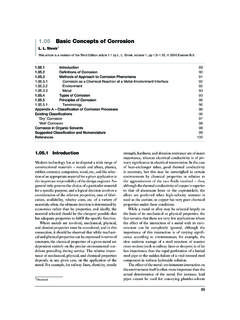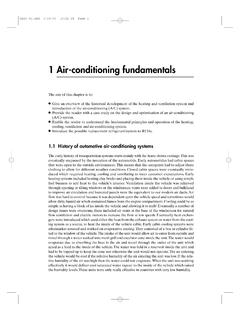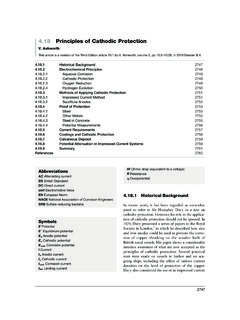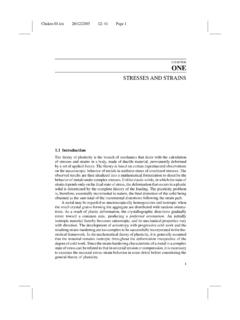Transcription of The Historical Context of Emergency Management
1 11 The Historical Context of Emergency ManagementWhat You Will Learn The early roots of Emergency Management . The modern history of Emergency Management in the United States. How FEMA came to exist, and how it evolved during the 1980s, 1990s, and the early twenty-first century. The sudden changes to modern Emergency Management that have resulted from the September 11 terrorist attacks and Hurricane Management has ancient roots. Early hieroglyphics depict cavemen trying to deal with disasters. The Bible speaks of the many disasters that befell civilizations. In fact, the account of Moses parting the Red Sea could be interpreted as the first attempt at flood control.
2 As long as there have been disasters, individuals and communities have tried to do something about them; however, organized attempts at dealing with disasters did not occur until much later in modern purpose of this chapter is to discuss the cultural, organizational, and leg-islative history of modern Emergency Management in the United States. Some of the significant events and people that shaped the Emergency Management discipline over the years are reviewed. Understanding the history and evolution of Emergency man-agement is important because, at different times, the concepts of Emergency manage-ment have been applied differently.
3 The definition of Emergency Management can be extremely broad and all-encompassing. Unlike other more structured disciplines, it has expanded and contracted in response to events, congressional desires, and leadership the most recent history, events and leadership, more than anything else, have brought about dramatic changes to Emergency Management in the United States. The terrorist attacks of September 11, 2001, led to massive organizational changes and programmatic shifts in Emergency Management . Many believe that these changes under-mined the effective national system of Emergency Management that had evolved during the 1990s and led to the profound failure of all levels of Emergency Management in response to Hurricane Katrina in 19/4/2007 4:12:31 PM9/4/2007 4:12:31 PM2 THE Historical Context OF Emergency MANAGEMENTA simple definition is that Emergency Management is the discipline dealing with risk and risk avoidance.
4 Risk represents a broad range of issues and includes an equally diverse set of players. The range of situations that could possibly involve Emergency man-agement or the Emergency Management system is extensive. This supports the premise that Emergency Management is integral to the security of everyone s daily lives and should be integrated into daily decisions and not just called on during times of Management is an essential role of government. The Constitution tasks the states with responsibility for public health and safety hence the responsibility for public risks with the federal government in a secondary role.
5 The federal role is to help when the state, local, or individual entity is overwhelmed. This fundamental philosophy continues to guide the government function of Emergency on this strong foundation, the validity of Emergency Management as a govern-ment function has never been in question. Entities and organizations fulfilling the Emergency Management function existed at the state and local level long before the federal government became involved. But, as events occurred, as political philosophies changed, and as the nation developed, the federal role in Emergency Management steadily the aftermath of the failed response to Hurricane Katrina, extensive discussion has centered about Emergency Management , particularly the response and recovery func-tions.
6 An ever-increasing presence of nonprofit organizations delivering support to their particular constituencies after Katrina has given rise to interest on the part of the non-profit community to take on increased responsibility for disaster response. This interest can best be attributed to the underlying belief that the federal government no longer can be relied on in disaster response and recovery. Both the actions of Congress and potential changes in the political leadership at the federal level may have a very strong influence on how this plays out in the near History: 1800 1950In 1803, a congressional act was passed to provide financial assistance to a New Hampshire town that had been devastated by fire.
7 This is the first example of the federal government becoming involved in a local disaster. It was not until the administration of Franklin Roosevelt began to use government as a tool to stimulate the economy that a significant investment in Emergency Management functions was made by the federal the 1930s, both the Reconstruction Finance Corporation and the Bureau of Public Roads were given authority to make disaster loans available for repair and reconstruction of certain public facilities after disasters. The Tennessee Valley Authority was created during this time to produce hydroelectric power and, as a secondary purpose, reduce flooding in the significant piece of Emergency Management legislation was passed during this time.
8 The Flood Control Act of 1934 gave the Army Corps of Engineers increased authority to design and build flood control projects. This act had a significant and long-lasting impact on Emergency Management in this country. The act reflected a philosophy that humans could control nature, thereby eliminating the risk of floods. Although this program would promote economic and population growth patterns along the nation s rivers, history has proven that this attempt at Emergency Management was shortsighted and 29/4/2007 4:12:31 PM9/4/2007 4:12:31 PMThe Cold War and the Rise of Civil Defense: 1950sThe next notable time frame for the evolution of Emergency Management occurs during the 1950s.
9 The era of the Cold War presented the principal disaster risk as the potential for nuclear war and nuclear fallout. Civil defense programs proliferated across com-munities during this time. Individuals and communities were encouraged to build bomb shelters to protect themselves and their families from nuclear attack from the Soviet every community had a civil defense director, and most states had some-one who represented civil defense in their state government hierarchy. By profession, these individuals usually were retired military personnel, and their operations received little political or financial support from their state or local governments.
10 Equally often, the civil defense responsibility was in addition to other support for these activities was vested in the Federal Civil Defense Administration (FCDA), an organization with little staff or financial resources, whose main role was to provide technical assistance. In reality, the local and state civil defense directors were the first recognized face of Emergency Management in the United companion office to the FCDA, the Office of Defense Mobilization, was established in the Department of Defense (DoD). The primary functions of this office were to allow for quick mobilization of materials and production and stockpiling of critical materials in the event of a war.











